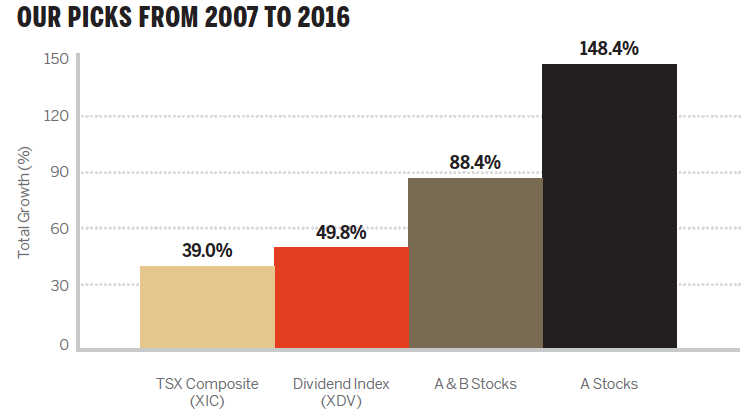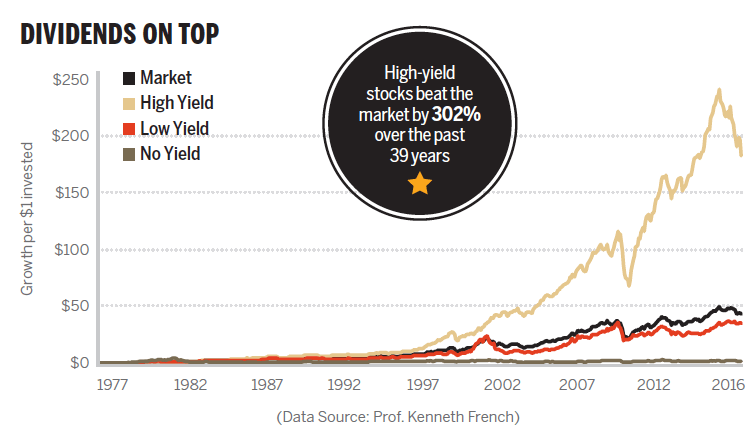Canada’s Best Dividend Stocks of 2016
Our A-graded stocks gained 14% on average this past year. See this year's All-Stars
Advertisement
Our A-graded stocks gained 14% on average this past year. See this year's All-Stars
The grim spectre of stagnation is reaching out from the grave of economics to drag down interest rates across the world. The yield on long-term Canadian government bonds has fallen to a mere 1.8%, but that’s sky high compared to the negative yields seen in Japan and parts of Europe.
It’s no wonder that investors are fleeing bonds and heading to the high seas of the stock market instead. They’re prepared to ride the market swells, and weather its storms, in the hopes of earning more than a dram of income over the long term.
We’re here to offer a steady hand on the tiller with this year’s MoneySense Dividend All-Stars, which steers investors to the best income-generating stocks in the land. (If our cream of the crop All-Star picks aren’t enough, see our ranking of the top 100 dividend stocks.) It marks the 10th anniversary of the strategy, which has profitably navigated through some big storms along the way.
Our top stocks steamed ahead in the past year. The A-graded stocks gained 14% on average while the combined A-and-B stocks climbed by an average of 13%. In comparison, the iShares S&P/TSX Capped Composite ETF (XIC), which tracks the broad Canadian stock market, advanced 11% and the dividend-oriented iShares Canadian Select Dividend ETF (XDV) gained 11% over the same period.

We’re pleased to say that our efforts have also been highly profitable over the long term. If you had purchased an equal dollar amount of each A-graded stock in your RRSP and rolled the proceeds into the new ones each year, you’d have gained a total of 148% since we started back in 2007. Similarly, a portfolio of A and B stocks would have climbed 88%. By way of comparison, the S&P/TSX Composite ETF (XIC) logged a return of 39% over the same period while the Select Dividend ETF (XDV) advanced 50%. (Returns include reinvested dividends.)
While our method provided an extra edge, we weren’t surprised by the outperformance of Canadian dividend stocks because market studies have extolled their virtues for a long time. For example, Dartmouth College professor Kenneth French studied stock-picking strategies in global markets and found that dividend stocks fared particularly well in Canada.
In one study French sorted Canadian stocks by dividend yield at the end of December and put them into three portfolios. The first portfolio held the 30% of stocks with the highest yields and the second contained the 30% of stocks with the lowest yields. The final portfolio tracked stocks that didn’t pay dividends. The portfolios were followed for a year and then the process was repeated. As a result, it was possible to calculate their returns over several decades.
The accompanying figure shows the growth of each portfolio along with that of the Canadian stock market. You’ll notice that the high-yield stocks handily outperformed the market by an average of four percentage points a year from 1997 through to the end of 2015. The low-yield group underperformed by 0.5 of a percentage point annually over the same period.
But take a gander at the miserable returns generated by the no-dividend group, which trailed the market by an average of 7.2 percentage points a year from 1977 through 2015. While it had a strong run in the late 1970s, the group peaked in 1981, and then crashed. Shockingly, the non-dividend payers failed to fully recover during the decades since then.
Aside from strong past performance, focusing on dividends can lead to behavioural benefits for many investors. Think of it this way: Stock market crashes cause a great deal of stress, but dividend yields rise when stock prices fall. That tends to make them more attractive to dividend aficionados. As a result, they’re more likely to load up–or at least stay invested– when prices are low. (Disclosure: I hold many of the stocks cited in this article.)

When looking for good dividend stocks we evaluate each candidate based on various measures for yield, reliability and value. We boil everything down to an easy to use letter grade that sums up a stock’s investment potential. Firms with the best prospects are awarded As and solid candidates get Bs. Both are worthy of your consideration. Middle-of-the-road firms get Cs while those in need of improvement get Ds or even Fs. Only seven stocks managed to earn As , while 11 picked up solid Bs.
Use our grades as the starting point for your own research. Before buying any stock, make sure its situation hasn’t changed in an important way and that it’s right for your portfolio. Read the firm’s latest press releases and regulatory filings. Scan the news to make sure you’re aware of important developments.
Look beyond the grades and think about the unique or intangible features of each company. Such factors can be beneficial, like a recent technological development. But they can also be detrimental, like the sudden arrival of new competition. Similarly, we’re in an aging bull market, which means that you should be prepared for storm clouds on the horizon.
While we’re pleased with our long-term track record, we can’t guarantee that you’ll make a fortune with every A- or B-rated stock. The market is just too wild and woolly for that. Nonetheless, we do think they deserve your attention and further research.
Share this article Share on Facebook Share on Twitter Share on Linkedin Share on Reddit Share on Email